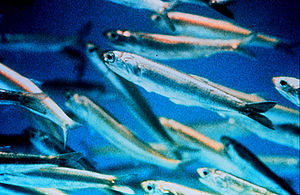- Oily fish
-
Not to be confused with Oilfish.
Oily fish have oil in their tissues and in the belly cavity around the gut. Their fillets contain up to 30 percent oil, although this figure varies both within and between species. Examples include small forage fish, such as sardines, herring and anchovies, and other larger pelagic fish, such as salmon, trout, hilsa and mackerel.
Oily fish can be contrasted with whitefish, which contain oil only in the liver, and much less overall than oily fish. Examples of whitefish are cod, haddock and flatfish. Whitefish are usually demersal fish which live on or near the seafloor, whereas oily fish are pelagic, living in the water column away from the bottom.
Oily fish are a good source of Vitamins A and D, and are rich in Omega 3 fatty acids (whitefish contain the same nutrients but at a much lower level).[1] For this reason the consumption of oily fish rather than whitefish can be more beneficial to humans, particularly concerning cardiovascular diseases,[2] but oily fish are known to carry higher levels of contaminants (such as mercury or dioxin) than whitefish.[3] Amongst other benefits, studies suggest that the Omega 3 fatty acids in oily fish may help sufferers of depression[citation needed] and improve inflammatory conditions such as arthritis.[4]
Contents
Health benefits
Dementia
French research published in 2002 in the British Medical Journal followed 1,674 elderly residents of southern France for seven years, studying their consumption of meat versus seafood and the presence of dementia symptoms. The conclusion was that people who ate fish at least once a week had a significantly lower risk of being diagnosed with dementia over a seven-year period.[5] However the study was unclear as to whether fish consumption protected against dementia, or if dementia prevented the participants from wanting more fish. There was also a possible confounding factor in that individuals with higher education have both a lower risk of dementia and higher consumption of fish.[6]
Ocular health
A 2009 study in the British Journal of Ophthalmology concluded that the Omega-3 fatty acids in oily fish were beneficial both in preventing the onset and slowing the progression of age-related macular degeneration in the elderly.[7] The researchers suggested that people at risk should eat two portions of oily fish per week.
Cardiovascular health
Consuming oily fish twice per week may also help prevent sudden death due to myocardial infarction by preventing cardiac arrhythmia.[8] The eicosapentaenoic acid found in fish oils appears to dramatically reduce inflammation through conversion within the body to resolvins, with beneficial effects for the cardiovascular system and arthritis.[9]
Recommended consumption
In 1994, the UK Committee on Medical Aspects of Food and Nutrition Policy (COMA) recommended that people eat at least two portions of fish per week, one of which should be oily fish.
In 2004 the UK Food Standards Agency published advice on the recommended minimum and maximum quantities of oily fish to be eaten per week, to balance the beneficial qualities of the Omega 3 fatty acids against the potential dangers of ingesting methylmercury (MeHg). The United States Environmental Protection Agency's (EPA) Exposure Reference Dose (RfI) for MeHg is 0.1 micrograms per kg body weight per day. The corresponding limit of blood mercury is 5.8 micrograms per liter. The restrictions apply to certain oily fish – "marlin, swordfish, shark and, to a lesser extent, tuna"[10]
The recommendations on maximum consumption of oily fish were up to four portions (1 portion = 140g, or approx 4.9 ounces) a week for men, boys, and women past childbearing age, and up to two portions a week for women of childbearing age, including pregnant and breastfeeding women, and girls. There is no recommended limit on the consumption of white fish.
The EPA and 2007 U.S. Department of Agriculture guidelines sets a limit only on consumption of fatty fish with greater than one part per million of methylmercury. Specifically tilefish, king mackerel, shark and swordfish. There are limits, however, for nursing/pregnant women and children under the age of six. This population should completely avoid fish with high risk of Mercury contamination (those listed above) and limit consumption of moderate and low-Mercury fish to 12 ounces or fewer per week. Albacore tuna should be limited to 6 oz or less per week.
Omega-3 content
Concerns about contamination, diet or supply have led to investigation of plant sources of Omega-3 fatty acids, notably flax, hempseed and perilla oil. Lactating women who supplemented their diet with flaxseed oil showed increases in blood and breastmilk concentration of alpha-linolenic acid and eicosapentaenoic acid but no changes to concentrations of docosahexaenoic acid.[11]
See also
References
- ^ [1][dead link]
- ^ "Oily fish helps heart attack victims to live longer - 07 October 1989". New Scientist. 1989-10-07. http://www.newscientist.com/article/mg12416851.600-oily-fish-helps-heart-attack-victims-to-live-longer-.html. Retrieved 2009-07-27.
- ^ "Food — Get cooking — Fish". BBC. http://www.bbc.co.uk/food/get_cooking/cooks_guide/fish.shtml. Retrieved 2009-07-27.
- ^ "Healthy diet can reduce arthritis symptoms". CANDIS. http://www.candis.co.uk/parental-and-family-health-news/294/Healthy_diet_can_reduce_arthritis_symptoms. Retrieved 2009-09-24.
- ^ Barberger-Gateau, P; Letenneur L, Deschamps V, Pérès K, Dartigues JF & Renaud S (2002). "Fish, meat, and risk of dementia: cohort study". British Medical Journal 325 (7370): 932–3. doi:10.1136/bmj.325.7370.932. PMC 130057. PMID 12399342. http://www.bmj.com/cgi/content/short/325/7370/932. Retrieved 2007-07-26.
- ^ Emma Wilkinson (2009-03-09). "Health | Oily fish dementia boosts queried". BBC News. http://news.bbc.co.uk/1/hi/health/7929071.stm. Retrieved 2009-07-27.
- ^ "Health | Oily fish 'can halt eye disease'". BBC News. 2009-06-08. http://news.bbc.co.uk/1/hi/health/8088860.stm. Retrieved 2009-07-27.
- ^ leaf, A.; Kang, J.X., Xiao, Y. & Billman, G (2003). "Clinical prevention of sudden cardiac death by n-3 polyunsaturated fatty acids and mechanism of prevention of arrhythmias by n-3 fish oils". Circulation 107 (21): 2646–52. doi:10.1161/01.CIR.0000069566.78305.33. PMID 12782616. http://circ.ahajournals.org/cgi/content/full/107/21/2646. Retrieved 2007-07-26.
- ^ Arita, M.; Bianchini F, Aliberti J, Sher A, Chiang N, Hong S, Yang R, Petasis NA & Serhan CN (2005). "Stereochemical assignment, antiinflammatory properties, and receptor for the Omega-3 lipid mediator Resolvin E1". Journal of Experimental Medicine 201 (5): 713–22. doi:10.1084/jem.20042031. PMC 2212834. PMID 15753205. http://www.pubmedcentral.nih.gov/articlerender.fcgi?tool=pmcentrez&artid=2212834.
- ^ Scientific Advisory Commission on Nutrition (2004). "Advice on Fish Consumption, Benefits and Risks". SACN. http://news.bbc.co.uk/1/hi/health/7929071.stm. Retrieved 2011-10-29.
- ^ Francois, C.A.; Connor, S.L. Bolewicz, L.C. & Connor, W.E. (1 January 2003). "Supplementing lactating women with flaxseed oil does not increase docosahexaenoic acid in their milk". American Journal of Clinical Nutrition 77 (1): 226–233. PMID 12499346. http://www.ajcn.org/cgi/content/full/77/1/226. Retrieved 2007-07-26.
Further reading
- Clover, Charles. 2004. The End of the Line: How overfishing is changing the world and what we eat. Ebury Press, London. ISBN 0-09-189780-7
External links
- Achieving optimal essential fatty acid status in vegetarians: current knowledge and practical implications (American Journal of Clinical Nutrition)
- "What's an oily fish?" from the UK Foods Standards Agency
- BUPA article on oily fish
- George Monbiot on the environmental problems of sourcing omega-3 from fish
Categories:- Edible fish
- Fisheries
- Oily fish
- Biologically based therapies
Wikimedia Foundation. 2010.




